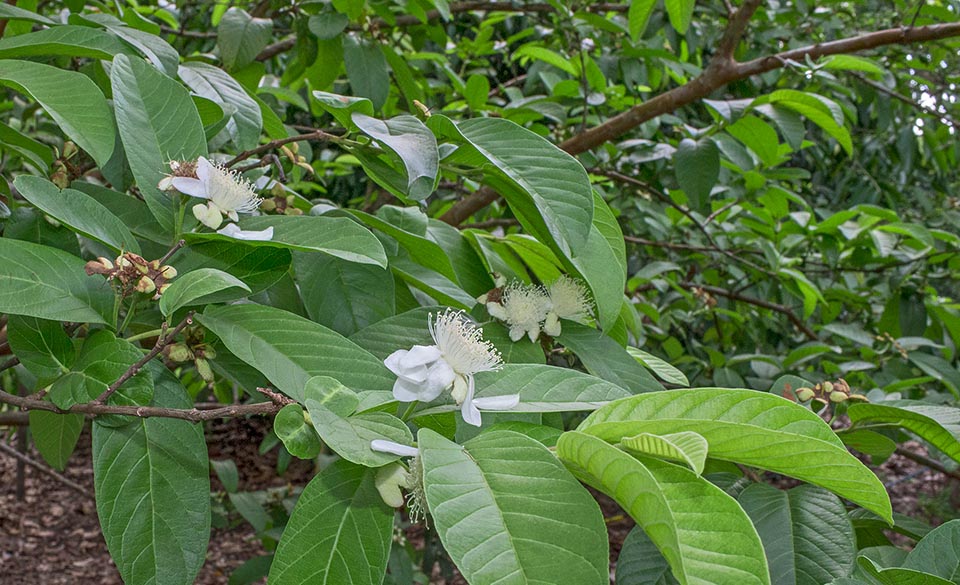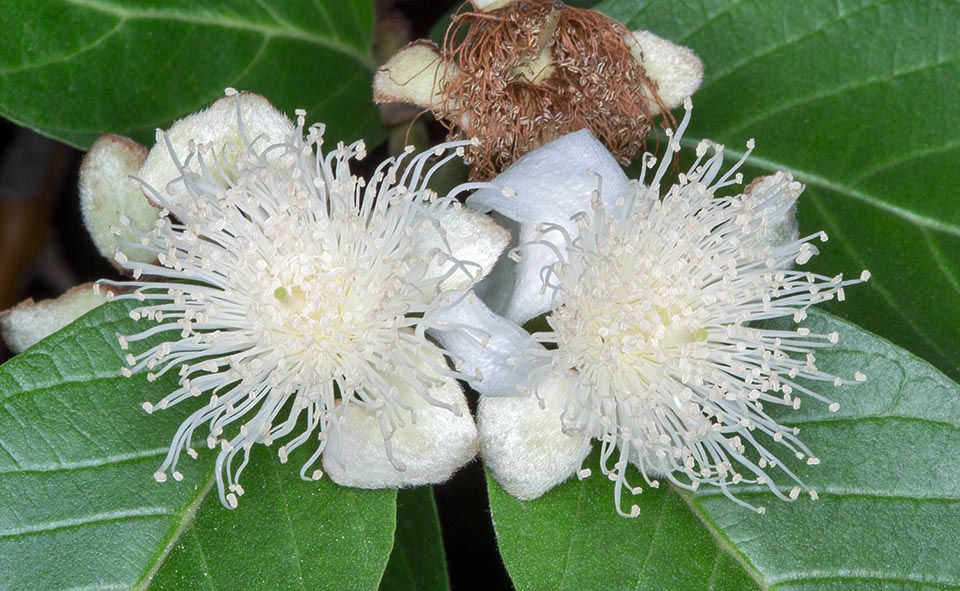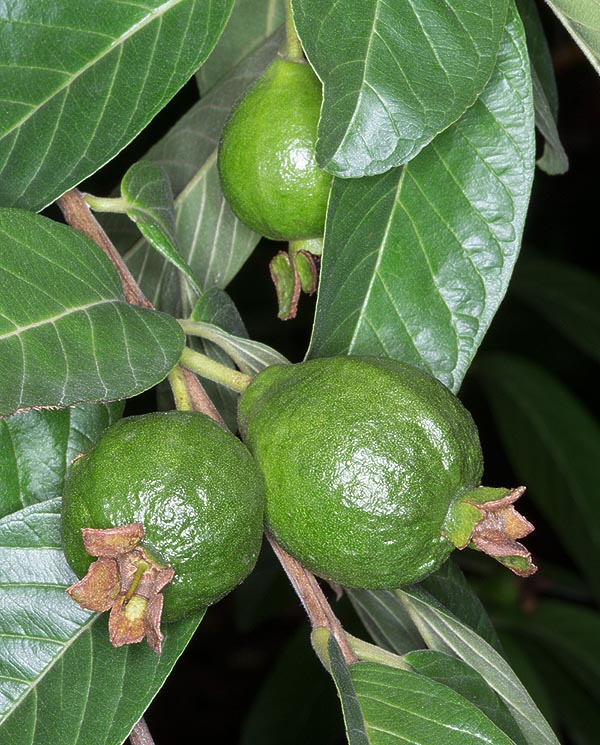Family : Myrtaceae

Text © Pietro Puccio

English translation by Mario Beltramini
The species is native to Belize, Bolivia, Cayman Islands, Colombia, Costa Rica, Cuba, Dominican Republic, Eastern Brazil, Ecuador, El Salvador, Guatemala, Haiti, Honduras, Leeward Islands, Mexico, Nicaragua, Northern Argentina, Panama, Paraguay, Peru, Puerto Rico, Trinidad and Tobago, U.S.A. (Florida), Venezuela and Windward Islands where it is present in the open forests and thickets from the sea level up to about 1500 m of altitude.
The name of the genus comes from the Greek substantive “ψίδιον” (psidion) = pomegranate, due to the resemblance of the fruits; the name of the species comes from the Spanish one “guayaba” utilized in South America, in turn derived from the name used by the Arawaks.
Common names: common guava, guava, lemon guava, yellow guava (English); malakapen (Burmese); goyaver (French); Guave, Guavenbaum (German); jamba, sapari (Hindi); jambu biji (Indonesian); araçá-goiaba, araçá-guaçú, goiaba, goiabeiro, guaiaba, guaiava (Portuguese-Brazil); mansala (Sanskrit); guayaba, guayabo (Spanish); bayabas (Tagalog); farang, ma-man (Thai).

The Psidium guajava is a very ramified fruit tree that in the open forests and thickets of tropical America can be 10 m tall © Giuseppe Mazza
Axillar flowers, on a 2-4 cm long pubescent peduncle, hermaphroditic, solitary or in groups of 2-3, with calyx having 4-6 unequal lobes, 1-1,5 cm long, retroflexed, of green colour and pubescent, persistent in fruit, 4-5 obovate petals with retroflexed apex, white, 1-1,8 cm long, and several white stamens with white anthers, 1-2 cm long. The fruit is a globose or pyriform berry, of 4-8 cm of diameter, green to yellow, with white, yellow or reddish pulp where are immersed numerous hard seeds almost pyriform, 3-4 mm long, of yellowish colour; varieties with few seeds or entirely without them have been selected.

The axillar hermaphroditic flowers, solitary or groups of 2-3, follow the typical scheme of the Myrtaceae with a pyrotechnic crowd of stamens © Giuseppe Mazza

The fruits of various colours, green to yellow, are globose or pyriform berries of 4-8 cm of diameter. Rich in vitamins, minerals, fibres and antioxidant, have a penetrant aroma and good taste, more or less sour. Seedless varieties have been selected. Roots, bark, leaves and fruits have medicinal virtues © G. Mazza
Among the tropical fruit trees is probably the most suitable species to be cultivated in pot, even of relatively contained dimensions, to be sheltered in protected ambient where the climate does not allow the permanence in open air during the coldest months. The premise must be as luminous as possible and the lowest temperatures over the 16 °C, the loam draining and rich of organic substance and regular waterings, but allowing to partially dry up before watering again, finally, with appropriate prunings, it is easy to maintain a contained and compact posture.
The fruits, consumed fresh or variously utilized for juices, jellies, preserves, ice creams, etc., present a high contents of vitamin C (up to more than 400 mg per 100 g of fruit in some varieties), A and B, minerals, fibres and antioxidants such as carotenoids and phenols.
The wood, hard and moderately resistant, is utilized for small objecst, poles and carpentry in general, furthermore it is excellent as fuel and for the production of charcoal.
Roots, bark, leaves and fruits are utilized since remote times in the traditional medicine of the local populations, in particular in the cases of diarrhea and dysentery and in the skin ailments.
Finally, are not to be neglected its ornamental characteristics due to its luxuriant foliage and the white blooming.
Synonyms: Psidium cujavus L. (1754); Psidium pomiferum L. (1762); Psidium pyriferum L. (1762); Psidium cujavillus Burm.f. (1768); Psidium angustifolium Lam (1789); Psidium pumilum Vahl (1791); Psidium vulgare Rich. (1792); Psidium sapidissimum Jacq. (1798); Psidium pomiferum var. sapidissimum (Jacq.) DC. (1828); Psidium pumilum var. guadalupense DC. (1828); Psidium aromaticum Blanco (1837); Psidium pyriferum var. glabrum Benth. (1840); Psidium fragrans Macfad. (1850); Psidium intermedium Zipp. ex Blume (1850); Psidium prostratum O.Berg (1856); Psidium guava Griseb. (1860); Guajava pumila (Vahl) Kuntze (1891); Guajava pyrifera (L.) Kuntze (1891); Psidium guajava var. cujavillum (Burm.f.) Krug & Urb. (1894); Myrtus guajava (L.) Kuntze (1898); Myrtus guajava var. pyrifera (L.) Kuntze (1898); Syzygium ellipticum K.Schum. & Lauterb. (1900); Psidium igatemyense Barb.Rodr. (1903); Psidium igatemyensis Barb. Rodr. (1903); Psidium guajava var. minor Mattos (1976).
→ To appreciate the biodiversity within MYRTACEAE family please click here.
